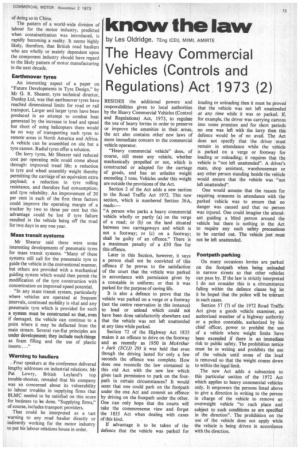know the law
Page 75

If you've noticed an error in this article please click here to report it so we can fix it.
lay Les Oldridge, TEng (CEO, MIMI. AMIRTE
The Heavy Commercial Vehicles (Controls and Regulations) Act 1973 (2)
BESIDES the additional powers and responsibilities given to local authorities by the Heavy Commercial Vehicles (Control and Regulations) Act, 1973, to regulate the use of heavy lorries in order to preserve or improve the amenities in their. areas, the act also contains other' new laws of more immediate concern to the commercial vehicle operator.
"Heavy commercial vehicle" does, of course, still mean any vehicle, whether mechanically propelled or not, which is constructed or adapted for the carriage of goods, and has an unladen weight exceeding 3 tons. Vehicles under this weight are outside the provisions of the Act.
Section 2 of the Act adds a new section to the Road Traffic Act 1972. This new section, which is numbered Section 36A, reads:—
"A person who parks a heavy commercial vehicle wholly or partly (a) on the verge of a road; or (b) on the land situated between two carriageways and which is not a footway; or (c) on a footway; shall be guilty of an offence." There is a maximum penalty of a £50 fine for this offence.
Later in this Section, however, it says a person shall not be convicted of this offence if he proves to the satisfaction of the court that the vehicle was parked in accordance with permission given by a constable in uniform; or that it was parked for the purpose of saving life.
It is also a defence to prove that the vehicle was parked on a verge or a footway (not the centre reservation in this instance) to load or unload which could not have been done satisfactorily elsewhere and that the vehicle was not left unattended at any time while parked.
Section 72 of the Highway Act 1835 makes it an offence to drive on the footway and as recently as 1950 in McArthur v Jack (SC(J) 29) it was held that even though the driving lasted for only a few seconds the offence was complete. How does one reconcile the law contained in this old Act with the new law which gives tacit permission to park on the footpath in certain circumstances? It would seem that one could park on the footpath under the one Act and commit an offence by driving on the footpath under the other. One can only hope that the courts will take the commonsense view and forget the 1835 Act when dealing with cases of this kind.
If advantage is to be taken of the defence that the vehicle was parked for
loading or unloading then it must be proved that the vehicle was not left unattended at any time while it was so parked. If, for example, the driver was carrying cartons into some premises and for short periods no one was left with the lorry then this defence would be of no avail. The Act does not specify that the driver must remain in attendance while the vehicle is parked on a verge or footway for loading or onloading; it requires that the vehicle is "not left unattended". A driver's mate, shop assistant, warehouseman or any other person standing beside the vehicle would ensure that the vehicle was "not left unattended".
One would assume that the reason for requiring someone in attendance with the parked vehicle was to ensure that no danger was caused and that no person was injured. One could imagine the attendant guiding a blind person around the vehicle but there is nothing in the Act to require any such safety precautions to be carried out. The vehicle just must not be left unattended.
Footpath parking On many occasions lorries are parked on the footpath when being unloaded in narrow streets so that other vehicles can pass by. If the law is strictly interpreted I do not consider this is a circumstance falling within the defence clause buI let it be hoped that the police will be tolerant in such cases.
Section 57 (7) of the 1972 Road Traffic Act gives a goods vehicle examiner, an authorized member of a highway authority or a police constable, authorized by his chief officer, power to prohibit the use of a vehicle where weight limits have been exceeded if there is an immediate risk to public safety. The prohibition notice must be in writing and prohibits the use of the vehicle until some of the load is removed so that the weight comes down to within the legal limit.
The new Act adds a subsection to this particular section of the 1972 Act which applies to heavy commercial vehicles only. It empowers the persons listed above to give a direction in writing to the person in charge of the vehicle to remove an overweight vehicle "to such place and subject to such conditions as are specified in the direction". The prohibition on the use of the vehicle does not apply while the vehicle is being driven in accordance with the direction.
























































































































